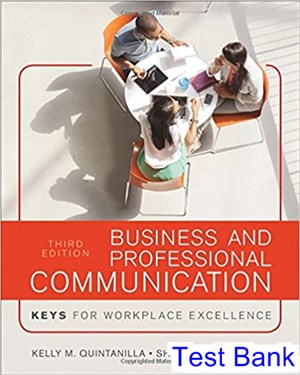Table of Content:
Part I: Beginning Communication Principles
Chapter 1: Business and Professional Excellence in the Workplace What Is Business and Professional Communication? Business and Professional Excellence in Context Understanding the KEYS Process Understanding the Importance of Human Communication in Business and Professional Contexts Communication: A Complex Process Social Media and Technology: Key Challenges in the Communication Age Communication Apprehension Communication Ethics KEYS for Excellence in the Workplace
Chapter 2: Verbal and Nonverbal Communication Verbal Communication Nonverbal Communication Codes of Nonverbal Communication Forming Relationships With Verbal and Nonverbal Communication KEYS To Excellence in Verbal and Nonverbal Communication
Chapter 3: Listening Hearing and Listening Barriers to Listening Listening Styles and Categories Improving Your Listening KEYS to Listening Excellence
Part II: Entering the Workplace
Chapter 4: Résumés, Interviews, and Negotiation The Job-Seeking Process Stage One: Exploring Stage Two: Researching Stage Three: Applying Stage Four: Interviewing Stage Five: Following Up Stage Six: Negotiating KEYS to Excellence in the Job-Seeking Process
Chapter 5: Getting to Know Your Diverse Workplace Learning Your Workplace Culture Assimilating College Students Diversity in Your Workplace: Some Important Concepts Examples of Diversityin Professional Contexts KEYS to Excellence in Getting to Know the Diverse WorkplacePart III: Developing in the Workplace
Chapter 6: Interpersonal Communication at Work Exploring Relationship Types at Work The Line Between Professional And Personal Professional Etiquette KEYS to Excellence in Interpersonal Communication
Chapter 7: Strengthening Teams and Conducting Meetings How Do Groups Differ From Teams? Conducting Meetings Shared Leadership Problem Solving Cultivating Innovative Thinking Conflict in Team Meetings KEYS to Excellence in Team Communication Part IV: Excelling in the Workplace
Chapter 8: Technology in the Workplace Communication and Technology: Tools for Professionals Drawbacks of Technology Professional Etiquette With Technology KEYS to Excellence With Communication and Technology
Chapter 9: Business and Professional Writing The Importance of Written Communication Types of Written Communication KEYS to Excellence in Written Communication
Chapter 10: Leadership and Conflict Management What Is Leadership? Utilizing Power Improving Communication With Leadership Theories Hiring the Right Team Following Up and Following Through Communicating About Your Team Dealing With Difficult People Giving Feedback Putting It Together Managing Your Public Image KEYS to Excellence in Leadership
Part V: Presenting in the Workplace
Chapter 11: Informing and Persuading The Importance of Presenting With Professional Excellence Identifying Presentation Opportunities and Purposes Speaking to Inform Speaking to Persuade KEYS to Excellence in Professional Presentations
Chapter 12: Speech Design Analyzing the Audience Analyzing the Context Researching Organizing Your Presentation Introductions Conclusions Language KEYS to Excellence in Speech Design
Chapter 13: Delivering a Speech With Professional Excellence Delivering a Presentation With Professional Excellence PowerPoint and Other Supporting Aids Practice Makes Perfect Team Presentations KEYS to Excellence in Delivering a Speech
Part VI: Surviving in the WorkplaceChapter 14: Work–Life Balance The Importance of Work–Life Balance Triggers to Imbalance Strategies for Balance KEYS to Excellence With Work–Life Balance














